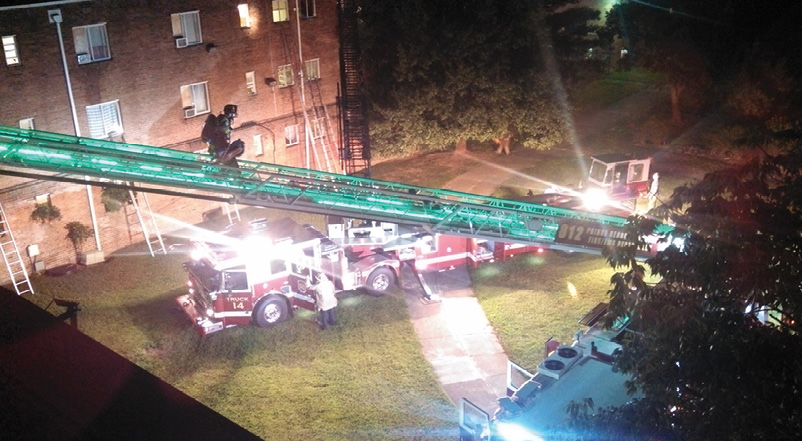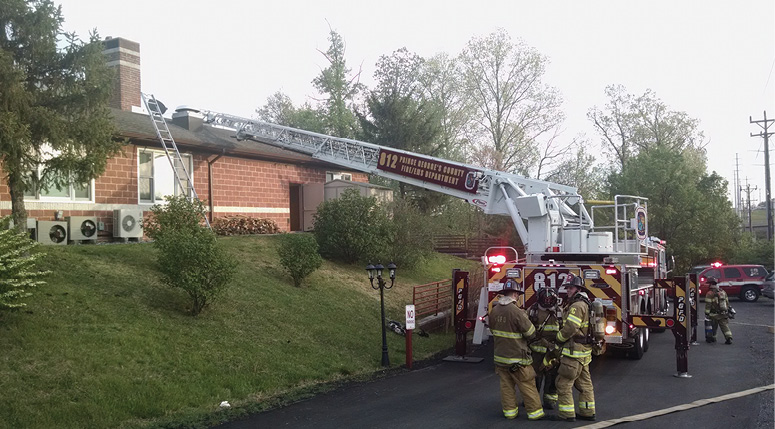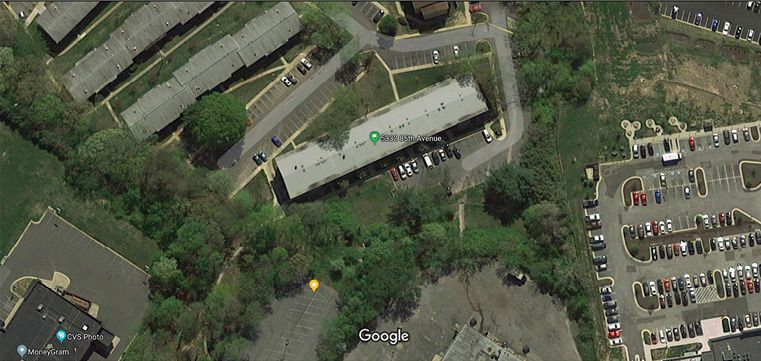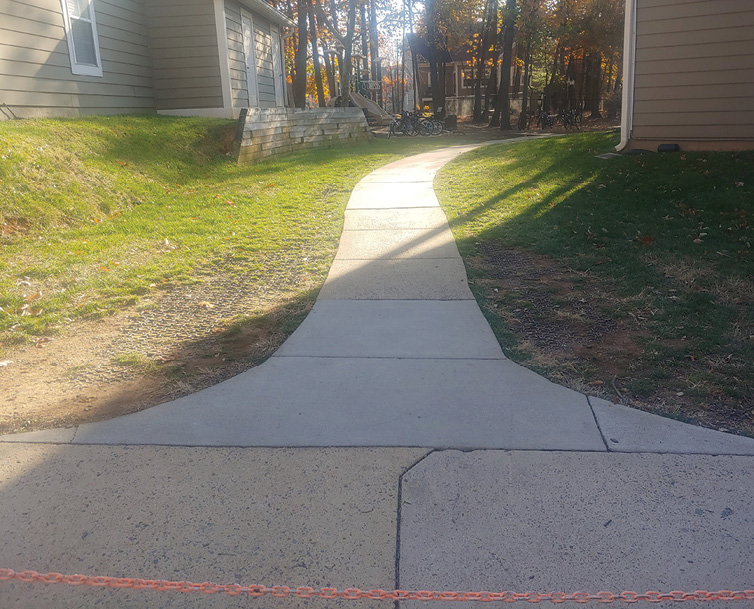
It is 3 a.m., and your department is dispatched as first-due to a fire in a residential building. The size-up reports there are three stories in the front and four in the rear and fire showing from side A. People are reported to be trapped on the top floor on the C side of the building; they are hanging out of the window. How are you going to get them out?
Almost every department can picture some building in its response area that fits this scenario. Whether you are responsible to staff a ladder truck or not, this one is for you. Only when we understand what other disciplines need can we support their operation.
RELATED TRAINING
AERIAL OPERATIONS FOR LOW-RISE BUILDINGS
Training Minutes Revisited: Removing Victims via Aerial Ladder
For most fire departments, the first option at a fire is to go interior and extinguish it. If the fire goes out, the problem goes away. For today’s scenario, let’s imagine your staffing and the building’s access do not make this a viable option. We will explore alternative options for making this rescue.
In the following sections are proposed solutions that fit into typical standard operating guidelines (SOGs). If you don’t have any related SOGs, these ideas present you with a starting point. Waiting until the call is dispatched is not an option; so whether it is training or equipping your department, you should be able to make this rescue.
No Truck Access
Suppose that there is no truck access to side C of this building. What equipment does your first-arriving apparatus carry to make a rescue? Consider the use of ground ladders. With a drop-off in the rear, the top-floor window is four stories off the ground. Allowing for common residential building practice, each floor is approximately 10 feet high, which, for this structure, amounts to at least 40 feet off the ground. If any of your fire apparatus carry a 35-foot ladder, you may be able to make this work. If not, where is the closest ladder 35 feet or longer coming from? Is one dispatched automatically? If not, how long will it take to call for one and have it arrive on scene? Simple things like sizing up your response area and identifying where you can reach and where you cannot can mean the difference between being a hero and being too late.

(1) Although the two aerial apparatus are positioned on the grass at side C of this apartment fire, both have spotted the outriggers safely on the concrete sidewalk, saving personnel about 300 yards of travel and giving a well-lit working area for crews. (Photos by author unless otherwise noted.)
If your department does not have a ladder truck, do you have one coming on reported structure fires? If not, why? Most departments without a ladder truck get caught up on the fact that the ladder truck is showing up for the big thing up top. In reality, with the changes in construction and modern building practices, this is not usually the case. We need these ladder trucks for the ground ladders. Most engines carry 24-foot ladders; few carry anything longer than a 28-foot ladder. This includes cities in which small alleys in the rear of buildings do not allow ladder truck access and rural America where the setback from the road is from 40 to 60 feet or greater. If your department does not have access to long ladders or your mutual-aid ladder trucks are not so equipped, you will have to find a solution to this scenario.
Paved Roads
What if the building has paved roads on all four sides? How do your tactics change? A ladder truck is en route, and the engine has done the right thing and positioned out of the way to allow the ladder truck full access to the building. Generally speaking, SOGs dictate that the first ladder truck be positioned on side A or the address side of the building. SOGs are just that, a guide. Arrival conditions and life safety can trump the guidelines; with good communication, we can deviate from them. If your department does not have SOGs, this is a good time to start developing them. SOGs ensure that all the units dispatched on the call start off on the right page—together! Your truck’s manufacturer, the truck type, and your department’s specifications all factor into how you will position it for this scenario.

(2) Who made it to the roof first? The firefighters throwing the ladders gained access more quickly and easily. Although you could use the big ladder up top, it may not be most appropriate for the situation, which depends on staffing and conditions.

(3) Positioned on side C of an apartment fire, this truck backed in and was able to reach the apartment building’s roof. As a result, the ladder bed was closer to the building and it was easier to get ladders in place. Even with uneven topography, they could navigate through the grass and gain access to the building.
Truck Manufacturer
The truck’s manufacturer plays a large role in where the truck can be positioned. Some manufacturers are now building ladder trucks with envelope controls. Envelope controls allow you to set up the truck in a smaller footprint than its maximum but reduce the allowable tip load or length of the ladder, depending on how far your outriggers are set. Other manufacturers still require you to short-jack the truck. In short-jacking, you do not extend one side of the jack fully. In most trucks, this will prevent you from operating off the short-jacked side. The ability to short-jack and the distance required to set up your outriggers are factors in your ladder truck’s operational footprint, which is the space needed to set up your truck fully jacked and the minimum distance from the building you need to operate your truck. This distance depends on your intended target. If the target is low on the building, the distance is one boom’s length. This will give you access to lower floors. To reach the upper floors, the operator’s manual dictates the distance. This will inform you how far away from the ladder truck the tip is at maximum extension and elevation. Parking closer or farther than the given distance diminishes the reach of your aerial. The operator’s manual has pertinent information, and every operator should read and understand it. The manufacturer should provide an operator’s manual when the truck is delivered. If it is not available in the firehouse, contact the manufacturer to get a new copy.
Truck Type and Specifications
The type of ladder truck and its specifications are other factors that affect your ability to position and operate your truck. For a mid-mount, it is important to position the side of the vehicle facing your target; this allows you to get low on your target. Pulling in reduces the scrub area; the cab will prevent you from going lower than the third floor in most cases. (The scrub area is the area of a building you can reach with the tip of your aerial device from a given location.) Specifications like raising the cab roof can impact where you can operate your aerial. A 20-inch raised cab roof could limit you to the fifth floor when pulling in using a mid-mount. Raising the cab roof, believe it or not, can equate to a loss of two stories of scrub area.
A rear mount allows a little more flexibility and gives you the opportunity to operate off the rear of the truck. But, if your rear mount was designed with high side compartments, this reduces your scrub area and limits your positioning. Again, this is a prime example of how knowing your truck’s strengths and weaknesses beforehand will help you quickly determine the right position for the given situation.
Pull In or Back In?
What do you have to consider during your approach? Among the first questions good operators consider is whether to pull in or back in. Some might suggest always backing in a rear-mount. Always and never have little use in the fire service. Let’s explore where this suggestion came from and when it is useful.
If you are unable to use the aerial device, pulling in or backing in can depend on where you want the ladder bed to point. If you back in, the ladder bed will be 40 feet closer to the building; and, if you have limited staffing, this could be the make or break for ladders going up. This also allows a buffer for the incoming engine companies so they don’t park too close and block your ladder storage. Backing in also gets the cab out of the way and allows access to the building’s lower floors. Getting the cab out of the way also decreases the distance from the turntable to your objective, giving you more reach.
Caution: If you back in too close to the objective, you will not have access to your ground ladder storage. You will still need to leave enough room to permit pulling the longest ladder out and away from the truck.
Pulling in has its advantages. Where backing in requires personnel to exit the vehicle and guide the driver back into position, which can delay important fireground operations, pulling in permits greater speed and efficiency. Backing in also accounts for a large number of accidents; pulling in helps limit the exposure. Additionally, pulling in gives the driver and officer a great view of the structure so the driver can better identify the target or targets where the aerial needs to go and place the turntable in the best position. When pulling in, if you can get the cab of the vehicle out of the way, it allows better access to the structure, increasing your scrub area.
Ultimately, when using the aerial device, pulling in or backing in comes down to turntable location. Where does my turntable need to go, how far away is my target, and how high or low is my target on the building? When the aerial is not needed or cannot be deployed, ground ladder storage becomes your priority.
Positioning Aids
Being a good operator involves listening to all radio traffic and using it to get the most advantageous positioning. Officers should assist the driver/operator by mapping out the scene and looking for good access. Some departments use map books to help guide them into the call, a great tool on which to add notes that lets truck companies know how to approach the building. Some will also use technology and look it up on a computer in the rig or on their personal cell phone. It’s okay to use this technology to your advantage. I have often used satellite views on mapping programs to assist in finding access. This will give you an overview of the building location and of the nearby roads, parking lots, and trees that may help or hurt you. In photo 4, College Park Truck 12 is using a nearby shopping mall parking lot to gain access to side A of an apartment building. Using a satellite view on a cell phone and cutting down a tree, they gained great positioning on a three-alarm garden apartment fire. There was no access to side A of the fire building from any other position (photo 5).

(4) An overview of an apartment complex in Prince George’s County, Maryland. The green marker indicates the call location. The yellow marker is the truck apparatus’s position. Using the adjacent shopping center parking lot, the officer guided the truck driver to the building’s side A. Using mapping technology, they spotted a way to gain access. (Imagery ©2019 Google, Imagery ©2019 Commonwealth of Virginia, Maxar Technologies, Sanborn, U.S. Geological Survey, Map data ©2019)

(5) At the same incident, the truck company cut down a tree in the rear of the parking lot to open access to the building’s side A. Since the entire parking lot was empty, backing in was easy and kept the front of the truck out of harm’s way.
Parking on the Grass
If the rear of the building is a grass lot, how does this change your approach? Do any of your department rules or regulations prevent you from placing your vehicle off the roadway? If so, why? Here, I am informing you of some skills you may use on the fireground.
Disclaimer: I do not advise anyone to disobey your department’s rules or regulations. But, we will discuss how we can potentially address this scenario while maintaining safety. Common statements such as, “The manufacturer would never recommend that you leave the pavement,” make sense. But, I would not expect a major manufacturer to own the blanket statement of leaving the roadway. As operators, we need to educate ourselves on when it is appropriate and when it is possible. We need to train and practice for these scenarios and create solid SOGs. Keep in mind that we do not want to limit our operators unnecessarily.
If the scenario described above were to occur after three days of heavy rain, I would be very hesitant to take my ladder truck off the pavement. Now, consider that you have had a week of below-freezing temperatures and the ground is frozen solid. That should change your mind. Even when operating on blacktop, be aware of on what we are setting our outriggers. We are looking for manhole covers and other surfaces that could be unstable. The same is true when leaving the paved roadway. Weather, topography, and overhead and ground obstructions affect your ability to access a building when leaving the pavement. Our job as operators is to know our trucks. We must become experts on what our truck can do and its limitations. As the operator, examine yourself and what you are capable of and comfortable with. Taking both of these factors into account, you need to figure out the combined limitations. Where are you comfortably going and where can the truck actually go?
It’s different for every operator and vehicle combination. The manufacturer is not responsible for your training. It gives useful information in the operator’s manual but it is up to you and your department to properly train personnel on the vehicle. It is important to understand the amount of pressure exerted on your outriggers and ground pads. It’s not a specific number you need to remember but rather understanding how much force is exerted and what material can handle it. This will aid you in determining where you can set up your ladder truck and on what surfaces. Tip load, ladder length, and the ladder manufacturer all factor in the force your outrigger/ground pad will exert. If you don’t know these variables, learn them.

(6) This fire lane is the only access to this garden apartment complex. Rubber matting is installed on both sides of the sidewalk to allow fire apparatus to drive down and access the building. The dirt and grass normally covering the matting washed away, exposing the matting.
Consider additional factors when leaving the roadway. While preplanning, I found that multiple buildings in my response area had rubber matting under the grass, which was designed and installed to support the weight of large trucks including fire trucks. Depending on your jurisdiction’s laws and codes, there may be access requirements to commercial and multiple-family dwellings. The builders can abide by these codes and still have green grass growing. They install this patented rubber matting and then plant grass over it. This allows weight to be distributed over a larger area.
Working with your plans reviewer or fire marshal, you can find out if this material has been installed anywhere in your response area. Do your research to find out who makes the matting and what its limitations are. Review your SOGs to see if they are up to date and allow fire trucks to use these access points. After all, they are installed for our use.
The scenario and options above are all proven to be effective through training and application. You have been given a scenario and a guide on how to conquer it. It is your obligation and responsibility to take this information and train and educate yourself and your department. It is imperative for you to take these topics back to the kitchen table and discuss them as a crew and as a department.
We should strive to fully understand how our ladder trucks work. Never forget that the big ladder up top is not the only reason the truck was dispatched to the scene. If you arrive at a one- or two-story house with limited staffing, would throwing a ground ladder be easier and faster than raising an aerial? Like anything else in the fire service, the training ground is where we want to find the answers—not when it’s 3 a.m. and lives are on the line.
Nick Wilbur is a firefighter with the Arlington County (VA) Fire Department where he has served for three years and is assigned to Fire Station 4. An 11-year veteran and a captain with the College Park (MD) Volunteer Fire Department, he has been a fire apparatus driver operator for eight years. Wilbur is an instructor for the Maryland Fire and Rescue Institute and is a certified Maryland Certification Review Board instructor. He has served as an FDIC International HOT instructor.

